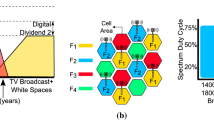Abstract
Interference is one of the significant issues in television white space (TVWS) that limits the scalability of secondary user networks, lowers the quality of service, and causes harmful destruction to primary users. Interference among secondary users is one of the severe problems in TVWS because there is no legal rule that governs the coexistence of secondary nodes in the available white space channels. Many studies have been conducted to recognize the presence of primary signals in order to identify spectrum gaps and avoid interference between primary and secondary users, but the majority of them failed to detect interference among secondary users. Furthermore, the few works that mitigate interference among secondary users, rather than detecting it, assume interference. Therefore, in this paper, we develop an interference detection algorithm using an energy detector. To enhance the energy detector’s functionality, we consider dynamic thresholds rather than static ones. We also modify the binary hypothesis to account for interference between two non-cooperative users coexisting in TVWS. We simulate the energy detector technique in MATLAB R2020a environment and utilised various signal-to-noise ratios (SNR) values. With an SNR of −8 dB, the proposed algorithm attains a maximum performance of 95.35% as the probability of detection and meets the standard set by IEEE 802.22 which requires the probability of detection to surpass or equal to 90%.
Access this chapter
Tax calculation will be finalised at checkout
Purchases are for personal use only
Similar content being viewed by others
References
Cisco. Cisco visual networking index (VNI) global mobile data traffic forecast update, 2017–2022 white paper. Comput. Fraud Secur. pp. 3–5 (2019). http://www.gsma.com/spectrum/wp-content/uploads/2013/03/Cisco_VNI-global-mobile-data-traffic-forecast-update.pdf
Zhou, X., Sun, M., Li, G.Y., Fred Juang, B.H.: Intelligent wireless communications enabled by cognitive radio and machine learning. China Commun. 15(12), 16–48 (2018)
Adetiba, E., Matthews, V.O., John, S.N., Popoola, S.I., Abayomi, A., Chen, K.: NomadicBTS : Evolving cellular communication networks with software-defined radio architecture and open-source technologies. Cogent Eng. 5(1), 1–15 (2018). https://doi.org/10.1080/23311916.2018.1507465
ITU (International Telecommunications Union). Measuring digital development. Facts and figures 2019. ITU Publ. pp. 1–15 (2019). https://www.itu.int/myitu/-/media/Publications/2020-Publications/Measuring-digital-development-2019.pdf
Okokpujie, K., Reuben, A., Ofoche, J.C., Biobelemoye, B.J., Okokpujie, I.P.: A comparative analysis performance of data augmentation on age-invariant face recognition using pretrained residual neural network. J. Theor. Appl. Inf. Technol. 99(6), 1309–1319 (2021)
Ahmed, H., Asaduzzaman.: Channel assignment augmentation algorithm to mitigate interference for heterogeneous ‘tV White Space’ users. In: 2018 Joint 7th International Conference Informatics, Electronics and Vision 2nd International Conference Imaging, Vision Pattern Recognition, ICIEV-IVPR 2018, no. June, pp. 200–205 (2019). https://doi.org/10.1109/ICIEV.2018.8641003
Yun, D.W., Lee, W.C.: Intelligent dynamic spectrum resource management based on sensing data in space-time and frequency domain. Sensors 21(16), 1–21 (2021). https://doi.org/10.3390/s21165261
Zhang, W., Yang, J., Guanglin, Z., Yang, L., Yeo, C.K.: TV white space and its applications in future wireless networks and communications: a survey. IET Commun. 12(20), 2521–2532 (2018). https://doi.org/10.1049/iet-com.2018.5009
Oluwafemi, I.B., Bamisaye, A.P., Faluru, M.A.: Quantitative estimation of TV white space in Southwest Nigeria. Telkomnika (Telecommun. Comput. Electron. Control 19(1), 36–43 (2021). https://doi.org/10.12928/TELKOMNIKA.V19I1.17881
Adekar, R.H., Kureshi, A.K.: Interference Mitigation of Heterogeneous Cognitive Radio Network using Spatial Diversity. 2, 3595–3601 (2019). https://doi.org/10.35940/ijeat.B4039.129219
Ranjan, R., Agrawal, N., Joshi, S.: Interference mitigation and capacity enhancement of cognitive radio networks using modified greedy algorithm/channel assignment and power allocation techniques (2020). https://doi.org/10.1049/iet-com.2018.5950
Wan, R., Ding, L., Xiong, N., Shu, W., Yang, L.: Dynamic dual threshold cooperative spectrum sensing for cognitive radio under noise power uncertainty. HCIS 9(1), 1–21 (2019). https://doi.org/10.1186/s13673-019-0181-x
Luo, J., Zhang, G., Yan, C.: An energy detection-based spectrum-sensing method for cognitive radio. Wirel. Commun. Mob. Comput. 2022, (2022). https://doi.org/10.1155/2022/3933336
Lorincz, J., Ramljak, I.: Algorithm for Evaluating Energy Detection Spectrum Sensing Performance of Cognitive Radio MIMO-OFDM Systems. pp. 1–22 (2021)
Ramírez, G.A., Saavedra, M.A., Araque, J.L.: Analysis of an energy detection algorithm for spectrum sensing. In: Proceedings of 2018 8th IEEE-APS Topical Conference Antennas and Propagation in Wireless Communication APWC 2018, no. September, pp. 924–927 (2018). https://doi.org/10.1109/APWC.2018.8503754
Arjoune, Y., El Mrabet, Z., El Ghazi, H., Tamtaoui, A.: Spectrum sensing: Enhanced energy detection technique based on noise measurement. In: 2018 IEEE 8th Annual Computing and Communication Workshop and Conference CCWC 2018, vol. 2018-Janua, pp. 828–834 (2018). https://doi.org/10.1109/CCWC.2018.8301619
Carrick, M.: Cyclostationary Methods for Communication and Signal Detection Under Interference Interference (2018)
Hendre, V., Murugan, M., Deshmukh, M., Ingle, S.: Transmit Antenna Selection with Optimum Combining for Aggregate Interference in Cognitive Underlay Radio Network. Wireless Pers. Commun. 92(3), 1071–1088 (2016). https://doi.org/10.1007/s11277-016-3593-1
Deshmukh, M.M., Zafaruddin, S.M., Mihovska, A., Prasad, R.: Stochastic-geometry based characterization of aggregate interference in TVWS cognitive radio networks. IEEE Syst. J. 13(3), 2728–2731 (2019). https://doi.org/10.1109/JSYST.2019.2904584
Fajemilehin, T., Yahya, A., Langat, K., Opadiji, J.: Optimizing cognitive radio deployment in cooperative sensing for interference mitigation. BIUST Research and Innovation Symposium 2019 (RDAIS 2019), vol. 2019, no. June, pp. 76–81 (2019). https://drive.google.com/open?id=168whyUBm9_N5lXw0gwGr-yDcYA2sMvys
Al Zubaer, A., Ferdous, S., Amrin, R., Romzan Ali, M., Alamgir Hossain, M.: Detection and false alarm probabilities over non-fading and fading environment. Am. J. Electr. Comput. Eng. 4(2), 49 (2020). https://doi.org/10.11648/j.ajece.20200402.13
Dannana, S., Chapa, B.P., Rao, G.S.: Spectrum sensing for OFDM cognitive radio using matched filter detection. Int. J. Recent Technol. Eng. 8(2), 1443–1448 (2019). https://doi.org/10.35940/ijrte.B2124.078219
kockaya, K., Develi, I.: Spectrum sensing in cognitive radio networks: threshold optimization and analysis. EURASIP J. Wirel. Commun. Netw. 2020(1), 1–19 (2020). https://doi.org/10.1186/s13638-020-01870-7
Acknowledgement
The Covenant University Centre for Research, Innovation, and Discovery (CUCRID) supported this investigation. This publication would not have been possible without the financial backing that was provided to the authors.
Author information
Authors and Affiliations
Corresponding author
Editor information
Editors and Affiliations
Rights and permissions
Copyright information
© 2023 The Author(s), under exclusive license to Springer Nature Switzerland AG
About this paper
Cite this paper
Notcker, J. et al. (2023). Interference Detection Among Secondary Users Deployed in Television Whitespace. In: Abraham, A., Pllana, S., Casalino, G., Ma, K., Bajaj, A. (eds) Intelligent Systems Design and Applications. ISDA 2022. Lecture Notes in Networks and Systems, vol 717. Springer, Cham. https://doi.org/10.1007/978-3-031-35510-3_39
Download citation
DOI: https://doi.org/10.1007/978-3-031-35510-3_39
Published:
Publisher Name: Springer, Cham
Print ISBN: 978-3-031-35509-7
Online ISBN: 978-3-031-35510-3
eBook Packages: Intelligent Technologies and RoboticsIntelligent Technologies and Robotics (R0)




